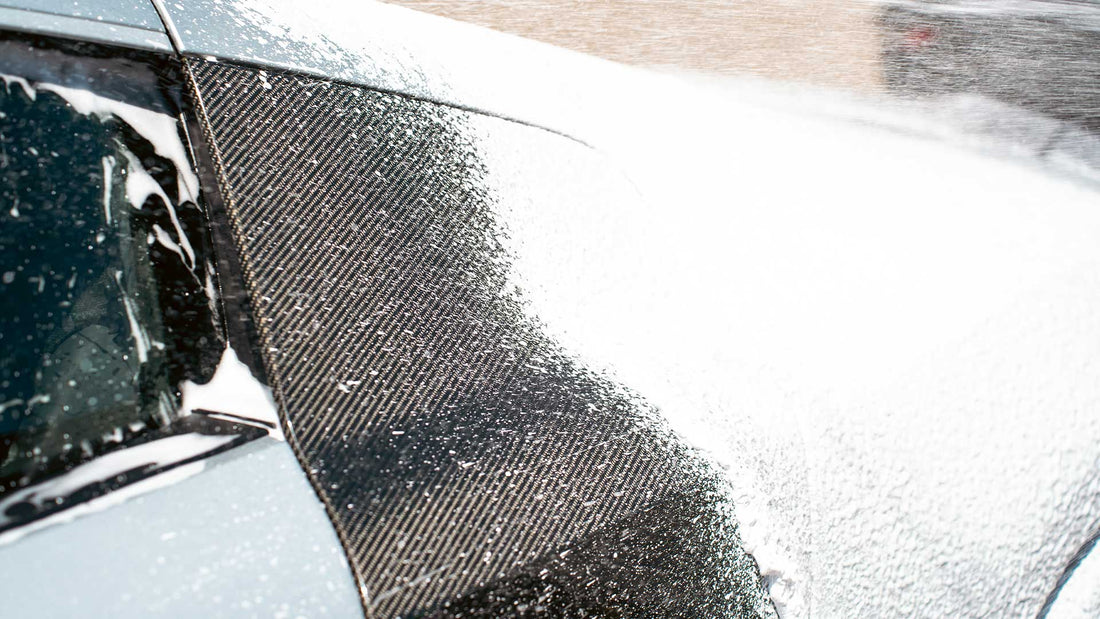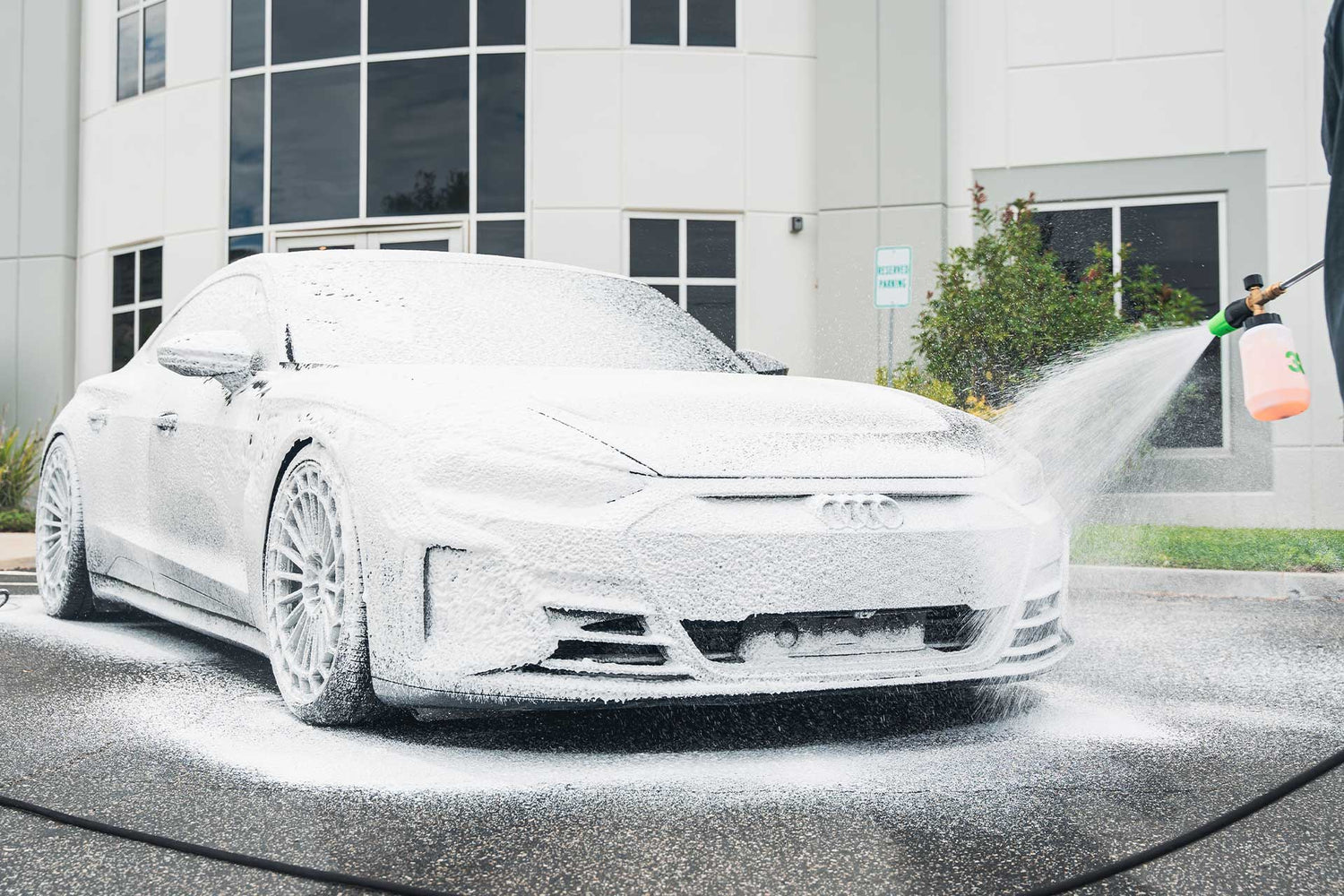
How to Restore, Protect and Maintain Carbon Fiber
Share
In the world of automotive aesthetics, performance and motorsports, carbon fiber holds a special place in the heart of car enthusiasts. Renowned for its strength, lightness, and sleekness, it’s a material that can enhance the look of any vehicle. In addition to aesthetics, it’s primarily used as a method of weight reduction in motorsports. However, like any other material, carbon fiber requires proper care and maintenance to keep it looking its best. In this guide, we will walk you through the essential steps to keep your carbon fiber components looking and performing their best.
We’ll explore how to restore oxidized, yellowed or faded carbon fiber, the best practices for protecting your carbon fiber from harmful elements like UV rays and extreme weather conditions, and also tips on maintaining your carbon fiber to prolong its lifespan and preserve its aesthetic appeal.
Whether you’re a car enthusiast with a carbon fiber-clad sports car or a casual driver looking to maintain your vehicle’s carbon fiber accessories, this article will serve as your comprehensive guide. Let’s jump into the world of carbon fiber care and maintenance.
Why and How Does Carbon Fiber Oxidize
Carbon fiber, a strong, durable and lightweight material, can oxidize or fade under certain conditions. The oxidation process is a result of exposure to extreme temperatures, UV rays, environmental changes, and weather. That said, the actual carbon fiber weaving isn’t the main culprit. That dull and hazy look is the result of the top layer of epoxy, resin or gel that has been oxidized, and not the carbon weave itself.
These resins and gels are extremely susceptible to UV damage and oxidation. In addition to oxidation, the gel coating can rapidly deteriorate and show stains or etchings when exposed to environmental elements such as bird droppings, bug splatter, tree sap, and more.
It’s important to note however, that these characteristics are typically found in inexpensive carbon fiber parts. Higher quality manufacturers and OEM parts are typically finished the traditional way using clear coats. Although a clear coat isn’t impenetrable, it’s far superior to resin, epoxy and gel coats.
Analyze the Condition of the Carbon Fiber
Before buying a whole bunch of products or setting up your workstation, you first need to analyze the current condition of the carbon fiber and what type of coating it has. For the sake of this guide, we’re going to use a heavily oxidized carbon fiber surface. However, you can skip steps if your carbon fiber isn’t as neglected as one that has been sitting untouched in the sun for months.
It’s also important to note that although gel coats and clear coats are very different from each other, the steps below can be applied to both types of coatings.

Carbon Fiber Restoration, Protection and Maintenance
Depending on how damaged and oxidized your carbon fiber may be, it can still be salvageable. The only thing this guide won’t get into is repairing physical damage such as exposed weaves, cracks and chips.
Phase 1: Preparation
Phase one is the most important step, as you need to ensure the surface of the carbon fiber is grime and contaminant free. The easiest way to do this is to use a waterless car wash spray. Liberally spray the surface and let it dwell, then simply wipe away the solution with a clean high-quality microfiber towel.
Once the surface has been cleaned, it’s time to decontaminate it. The best way to do this is to use a clay bar, clay towel, or clay pad and a quality clay lubricant. This is especially important if you’ll be polishing the surface, as embedded contaminants can cause damage during the polishing process.
After the surface has been cleaned and decontaminated, another quick cleaning is required to get rid of any residual clay lubricant. Again, you can use the waterless car wash spray method, or do a quick wash down with a pH neutral car wash soap. Be sure to thoroughly dry the surface before moving onto the next step.
Phase 2: Polishing
Phase two is the polishing step. Our arsenal of compounds has a wide variety of options, however for a project like this, 3D ONE is the go-to. 3D ONE is a hybrid cutting and polishing compound that turns an otherwise tedious process into an all-in-one process. This hybrid compound is perfect for removing swirls, haze, oxidation and other imperfections.
Start off by masking off any surrounding panels or trim that you don’t want polished, as this can cause unwanted abrasion. Using a spider-cut foam pad and your preferred polisher, apply a few pea-sized drops of 3D ONE. Spread the compound over the area you’re working on using the lowest speed setting. From there, increase the speed and work the compound on the entirety of the surface using a crosshatch motion and light pressure.
Swap to a fresh pad of the same type and hit the surface of the carbon again, this time using a slightly lower speed setting. Repeat this for two passes to ensure the compound is fully broken down. Using a fresh microfiber towel, thoroughly wipe away any compound residue.
Phase 3: Protection
After a quick decon and restoration polish, you’ll be left with a carbon fiber surface that looks brand new. However, without adding the proper protection, you’ll be repeating this process a lot sooner than you’d like. Whether your carbon fiber pieces are clear coated or gel coated, the following methods are a great way to promote longevity, UV protection and environmental protection.
There are three ways to efficiently protect a freshly polished carbon fiber surface. One is to ceramic coat it, and the second is to wax it. The third way is to wrap it with a paint protection film. Now, this solution is costly and in some cases, not realistic for most people. So, we’re going to focus on ceramic coating and wax for simplicity.
Ceramic Coating: Using a graphene infused ceramic coating, apply an even layer of the product on the carbon fiber surface with your applicator. If you’re working on a large surface, such as a hood, work in sections. Once the coating has bonded with the surface and has dried, wipe away any residue with a clean microfiber towel. Keep in mind that ceramic coatings need to cure for at least 48 hours, and will continue to harden for roughly seven days.
Wax: Wax is a cost-effective solution that’s much more forgiving than ceramic coating, but still boasts exceptional protection. With the addition of our new 3D GLW Series SiO2 Ceramic Wax, you get the best of both worlds. Squeeze out some wax onto an applicator and apply it to the surface evenly. Let the wax cure for 10 to 15 minutes and, similarly to ceramic coating, dry to a haze. Using a fresh microfiber towel, simply wipe away any excess residue. If you’re unsure on how to properly wax a car, check out our step-by-step waxing guide.
Phase 4: Maintenance
The hard part is done! With proper maintenance and care, you’ll keep your carbon fiber accessories looking better for longer. Here are a few tips on how to properly maintain a freshly revitalized carbon fiber piece:
Ceramic Detail Spray: Using a hydrophobic ceramic booster is a great way to not only keep your car clean, but enhance the effects of a ceramic coating or even ceramic wax.
Ceramic Car Wash Soap: In addition to ceramic boosters, using a pH neutral ceramic car wash soap is another great way to get a deep clean and enhance the effects of ceramic coating or ceramic infused products.
Proper Washing Methods: Always follow the proper pre-wash and contact wash techniques during maintenance washes. That last thing you want to do is swirl, haze or scratch the surface you just got done polishing.
Regular Washing: On top of proper washing methods, you want to perform regular washing schedules. Typically washing the car once at least every one to two weeks is a good way to keep the car clean and free of contaminants that can damage coated surfaces.

The 3D Way
In the end, proper care and maintenance of carbon fiber is essential for preserving its aesthetic appeal. By understanding the causes and effects of oxidation, and following the appropriate restoration, protection, and maintenance procedures, enthusiasts and car owners can ensure that their carbon fiber components remain in top condition. Whether it's restoring faded carbon fiber, protecting it from environmental elements, or maintaining its luster, the investment of time and effort in carbon fiber care will pay off in the form of long-lasting, visually stunning, and high-performance automotive components. So, as you venture into the world of carbon fiber, remember that proper care and maintenance are the keys to unlocking the full potential of this exceptional material.

